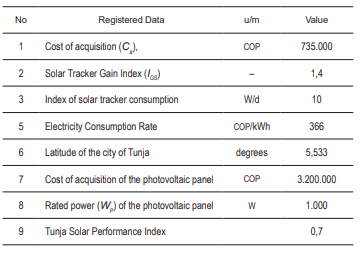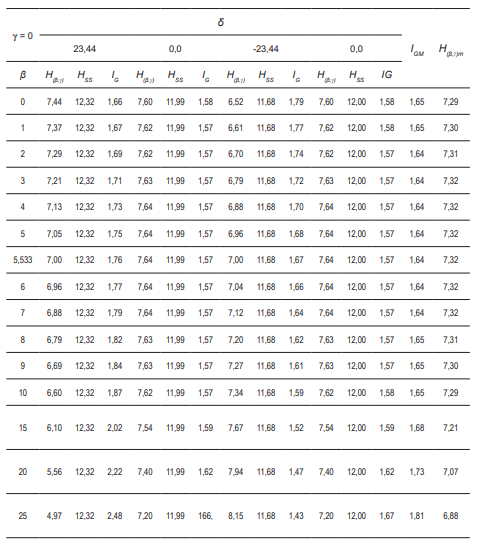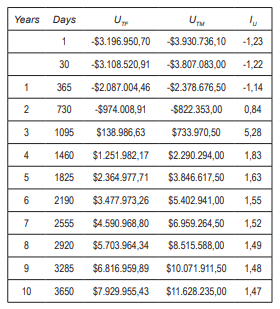I. INTRODUCTION
Currently, in many developing countries, there still exist areas where electrical energy is not available [1], the fundamental cause being a disperse, low-income, rural population in regions where access is difficult. Because of this, taking advantage of low cost and highly efficient photovoltaic solar energy [2], [3] represents one possible solution. The use of solar trackers represents an alternative to improve efficiency during the exploitation of solar energy [4], [5]. This mechanism ensures that the light with maximum intensity will be falling on the solar panel throughout the day. In others words, it is an effort to increase the efficiency of power generation through the solar module.
In the international market, a diverse selection of solar trackers exists, however, end-users do not have a guide or method that allows them to decide whether using one is viable in specific operating conditions. Additionally, comparative indexes are not available to evaluate whether the gain indicated by the producer and paid for corresponds with the operating results of the solar tracker.
An analysis of the techno-economic efficiency (kWh/$) of solar technologies such as photovoltaic generator and solar heater, allows us to conclude that they are not financially viable on the global market with respect to other traditional technologies that are available to produce heat and electricity. To take into account the studies carried out by [6], “the cost factor is more important than the efficiency”. Considering this information and the need that exists to design and develop a hybrid micro technology in order to generate electric and caloric energy at a low cost to rural zones without supplied electricity, it becomes necessary to research solar trackers inclu- ding determining how much the efficiency of solar technologies could be improved.
Upon numerous reviews of solar trackers, it can be concluded that indexes or methodology to evaluate its usage do not exist. There are, however, some comparative analyses of solar tracker usage, according to studies carried out by authors [7]-[21]. Taking into account that, from a scientific perspective, no indexes have been designed to evaluate the viability of the use of a solar tracker for a specific solar energy facility, providing objective elements to make the decision to select or not that technology, the aim of this work was to design a group of techno-economic indexes and to propose a procedure based on these indicators which allow for the user to be guided in order to properly select and/or evaluate a solar tracker and, consequently, to determine whether its use is viable. The hypothesis is: the existence of a methodology based on techno-economic indexes would permit evaluating the solar trackers, and to determine whether its use is viable.
It is known that the nominal power (Pn) of a photovoltaic generator is calculated during operation in a fixed horizontal position (β = 0), with a solar irradiance coefficient Io = 1kW/m2, a determined spectrum of radiation falling upon it and cells that continue working at a temperature of 25° C [22]-[25]. However, by using solar trackers (mobile supports) their operational power could be increased by between 25-55% [26] - [30]. How can it be determined whether the use of solar trackers is economically viable?
It is known that the average density of the solar radiation that arrives at the highest part of the atmosphere is 1366 W/m2 [23], [31], known as the solar constant. Notwithstanding, due to the phenomena of reflection, absorption and atmospheric transmittance along with the infrequent occurrence of clear sky conditions, the maximum irradiance value observed at the surface of the earth is Io = 1kW/m2.
When assessing the energetic potential of a region, the parameter which needs to be calculated is the irradiance: the quantity of energy irradiated (H) in a period of time calculated by the formula  , referred to assolar irradiation between two moments of time [24]. This formula can be used to make daily, monthly or yearly calculations where I(t) is the real function of irradiance, established for different moments of time.
, referred to assolar irradiation between two moments of time [24]. This formula can be used to make daily, monthly or yearly calculations where I(t) is the real function of irradiance, established for different moments of time.
In this study, it is assumed that the gain index (IG) of a solar tracker is the relation between the quantity of energy generated during a period of time by a piece of technology exploiting solar energy installed on a mobile sup- port, with respect to the quantity of energy that is possible to generate in the same period of time by the same technology, were it to be installed on a fixed support.
To carry out the calculation, it is necessary first to determine the maximum quantity of energy that it is possible to generate using technology moun- ted on an ideal mobile support, which at every moment of time modifies the Polar angle (β) and Azimuth angle (γ) values of the surface receiving solar rays and ensures that the Incidence angle (θ) on the receiving surface is zero degrees, for which its cosine will always be the unit and it will be calculated using the formula (1):
In (1) it is understood that:
EGSS - Quantity of energy generated by a piece of solar technology mounted on a mobile support or a solar tracker;
ts - Time of sunrise;
tp - Time of sunset.
Note that in the given situation, EGSS coincides with the maximum possible irradiated energy.
Given that cos(θ) = 1, the formula (1) transforms into (2):
However, for a case in which the support is fixed, as the hours and days go by, the angle θ varies [32], because of which the calculation of its value at a given moment may be realized by using the formula (3):
whence,
δ - Solar declination;
ω - Daylight hours’ angle;
φ - Latitude;
i, j, k - Unit vectors;
β - Polar angle;
γ - Azimuth angle.
The cos(θ) is obtained as a vector product of solar vector (  , given in equation (4), by the normal vector (
, given in equation (4), by the normal vector ( ) to a surface with an arbitrary orientation on the earth, which appears in equation (5)
) to a surface with an arbitrary orientation on the earth, which appears in equation (5)
According to studies carried out by various authors [23], [33] and calculations included in the present study (see Table 1), the best solar ray capture variant would be for a surface with an inclination angle of β = φ fixed throughout the year (that is, equal to the angle given by the latitude of the place) and focused towards the south, because of which the Azimuth angle γ = 0. If said values are substituted into formula (3), an incidence angle of solar rays on the Surface would be given by:
If formula (6) is integrated for the irradiance of I0 in a period of 24 hours, the maximum possible irradiation of the surface is obtained, which would be considered as the maximum quantity of energy that a piece of solar technology mounted on a fixed support could generate with the angles β= φ y γ = 0, formula (7):
Definitively, the highest quantity of energy that can be generated by a piece of solar technology on a fixed installation (EGF) is given by formula (8):
For the calculation of the gain index for any angle β and any angle γ, formula (3) is integrated for the irradiance of I0 in a period of 24 hours and formula (9) is obtained:
II. METHODOLOGY
The process for the calculation of the indexes will allow for the adequate selection and evaluation of a solar tracker, to determine the viability of its use.
Calculation methodology
From the equations available in the introduction of this study and their respective relations, this study proposes the calculation of the following indexes:
1. Index of theoretical gain (IG) of the solar tracker: obtained by dividing the maximum possible generation with a mobile support, formula (2), by the maximum generation possible with a fixed support, given by (8):
Note that the theoretical gain index over the course of a year can take different values: a maximum value when the Earth is in summer solstice (20/21 June) where δ = 23,44 degrees and IG = 1,76; a minimum value when the Earth is at the spring equinox (20/21 March), when δ = 0 and IG = 1,57 for the specific geographical conditions, see Table 2.
2. Solar tracking consumption index (ICS): is defined as the total consumption of electric energy of its motors, in a unit of time, needed to be able to track the solar rays.
3. Comparative gain index (ICG): the ratio between the solar tracker’s gain index and the maximum average gain (IGM) that can be obtained with a solar tracker over the course of a year. It is calculated as the mean value for the four seasons of the year, taking specifically the values corresponding to the summer and winter solstice and spring and autumn equinoxes.
whence,
IGS - Index of solar tracker gain by manufacturer.
4. The utility of solar technology without solar tracker (with fixed support) UTF is calculated by the expression:
whence,
CTF - Cost of the acquisition of the technology of electrical energy production from solar energy, mounted on a fixed support;
Tf - Electricity consumption rate in the locality where the analysis will be carried out;
Pop - Operating power of the solar technology taking into account the factor of solar peak hours;
∆t - Time interval for which the utility analysis is performed. It can be a day, a month, a year, etc.
5. The utility of solar technology with solar tracker (with mobile support) UTM: is calculated by the expression:
So:
CS - Acquisition cost of solar tracker.
6. Index of utility: relation between the utility with mobile support and the utility with fixed support:
With the proposed indexes, the solar tracker is selected and/or evaluated by the following procedure:
The commercial data of the solar tracker are obtained: Cost of acquisition (CS), Index of profit (IGS), Index of consumption (ICS).
The commercial data of the electric production technology from the solar energy are obtained: Cost of acquisition (CTF), Nominal power (Pn).
Data are obtained from the location where the technology will be installed: latitude, solar peak hours or solar performance index (IRS), as well as the electric consumption tariff (Tf) of the locality.
The maximum average gain (IGM) and the operational power of the technology (Pop) are calculated for the geographic and climatological conditions of the place where the technology will be installed.
The Gain Comparison Index (ICG) is calculated.
The utility of technology with fixed support and mobile support for a certain time interval (usually one year) is calculated.
The utility index is calculated.
The analysis is carried out and decisions are made as to whether or not the use of the solar tracker is feasible for the operating conditions of the electric energy production technology from solar energy.
III. RESULTS AND DISCUSSION
Once the procedure was developed, it was applied to evaluate a mobile support. The data are recorded in Table 1. The data of the calculations of gain indexes are shown in Table 2, while the values of the utility index appear in Table 3.
On Table 2, it can be observed that the average gain index (IGM) is very stable for inclination angles between 0 and 10 degrees, as well as the production of electric energy from fixed-beam solar technologies (H(β,γ)). However, by increasing the inclination angle of the fixed support, the generation of fixed technology decreases its production and increases the rate of gain.
Table 3 shows that the usefulness of UTM mobile technologies for short periods (less than one year) is lower than the usefulness of fixed technologies due to their investment costs. However, as of the second year of operation, the profits of the mobile technologies are higher than the fixed ones and it is reflected in a positive utility index IU = 0,84, with a rapid tendency to grow. It becomes more stable as time goes on, with a slight tendency to decrease, due to the consumption of the engines for the mobile technologies. The factors that would increase the utility index would be a higher profit rate (from 1,4 to 1,64), a decrease in solar tracker investment costs, as well as engine consumption. It should be noted that the utility index has a faster growth rate for technologies with higher nominal powers.
IV. CONCLUSIONS
This investigation proposed a group of techno-economic indexes (average gain, comparative efficiency and profitability) as a first stage in the contribution to the decision-making process on the suitability, or lack thereof, to use a solar tracker. With the designed indicators, a procedure that permits to evaluate the viability of the use of a solar tracker for a specific solar energy facility was developed, providing objective elements to make the decision; that is to select or not to select that technology. The use of solar trackers for technologies of greater power favors its utility index.
With the calculations made on the gain index, it can be observed that the average value obtained for fixed installations with an inclination angle equal to the latitude of the site is superior to the values registered in the literature, which shows the possibility of designing and developing trackers with higher solar gain, lowering manufacturing costs and lowering consumption rates as a way of using them in low-power photovoltaic generators.































